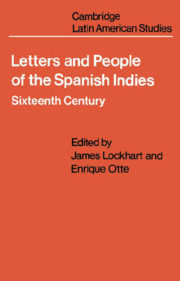Book contents
- Frontmatter
- Contents
- Preface
- Part I Conquest
- Part II The Variety of Life in the Indies
- 11 An encomendero's establishment
- 12 An encomendero's opinions
- 13 The miner
- 14 Commerce across the Atlantic
- 15 The professor of theology
- 16 The new arrival
- 17 The tanner and his wife
- 18 The troubadour
- 19 The nephew
- 20 The garden and the gate
- 21 The woman as settler
- 22 The farmer
- 23 The petty dealer
- 24 The Flemish tailors
- 25 The nobleman
- 26 The Hispanized Indian
- 27 Indian high society
- 28 An Indian town addresses the king
- Part III officials and Clerics
- Bibliography
- Index
17 - The tanner and his wife
from Part II - The Variety of Life in the Indies
Published online by Cambridge University Press: 06 August 2018
- Frontmatter
- Contents
- Preface
- Part I Conquest
- Part II The Variety of Life in the Indies
- 11 An encomendero's establishment
- 12 An encomendero's opinions
- 13 The miner
- 14 Commerce across the Atlantic
- 15 The professor of theology
- 16 The new arrival
- 17 The tanner and his wife
- 18 The troubadour
- 19 The nephew
- 20 The garden and the gate
- 21 The woman as settler
- 22 The farmer
- 23 The petty dealer
- 24 The Flemish tailors
- 25 The nobleman
- 26 The Hispanized Indian
- 27 Indian high society
- 28 An Indian town addresses the king
- Part III officials and Clerics
- Bibliography
- Index
Summary
Alonso Ortiz, in Mexico City, to his wife Leonor Gonzalez, in Zafra, Extremadura, c. 1574-1575
. .. I am pressed and hemmed in to earn a living for you and my children …
The letter of tanner Alonso Ortiz illustrates two common phenomena. The first is one of the basic processes in the formation of Spanish American society. Artisans of all kinds came to settle in the Spanish cities, catering to the needs of a population which could pay in silver coming from the mines and encomiendas. Starting with nothing but their tools, Spanish craftsmen would at first perform most of the productive work themselves. If they had any success at all, they began to train helpers and expand, until they themselves graduated into supervision and marketing, while much of the shop work was done by blacks and Indians. Often, as here, the blacks, though slaves (or indeed because they were slaves and more permanent), were the foremen and most skilled workers, while the apprentices and less skilled were Indian. This sort of shop organization accomplished some things of vast cultural signific∼nce: it greatly increased the productivity of Spanish crafts, fllling the larger cities with Spanish- style artifacts and services, and second, it was a prime factor in hastening the growth of a non-Spanish but Hispanized sector of the urban population. Skilled help was scarce and much in demand, so that Alonso Ortiz could find none at first. But now, after only a year, aided by a partner, he has trained or acquired a force of nine, and is showing a good profit.
Ortiz mentions the possible export of some cured hides to Spain. Let it be clear that his most important market is local, Mexico City itself. All Ortiz envisions is sending a hundred or so of the best hides from among the thousands he cures. His first attempt to do so came to nothing, and his plan for the future is most hypothetical. The export of hides to Europe was a quite marginal, unprofitable business until lower freight costs and higher demand finally made it really viable.
The second phenomenon is related to the fact that a certain number of immigrants to the Indies were married men unaccompanied by their wives.
- Type
- Chapter
- Information
- Letters and People of the Spanish IndiesSixteenth Century, pp. 119 - 123Publisher: Cambridge University PressPrint publication year: 1976



